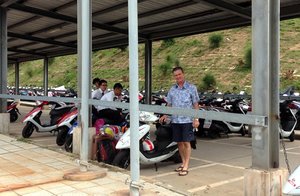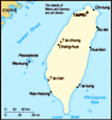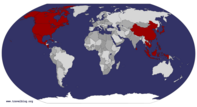Advertisement
Published: October 4th 2015

 Picking Up Our Scooter
Picking Up Our Scooter
The agent met us in the airport, filled in a form, and for $350NT, we had the use of a 125 Sym for 60 hours.After a month and a half of school, it was nice to finally get a break. The Moon Festival gave us a long week-end, so we booked a trip to Kinmen Island through Vivien at the school. She booked our flights, 60 hours of scooter time and a homestay in a typical Fujian B&B.
We left for the airport Saturday around 7:30AM and landed in Kinmen at 10AM. We made our way to the Visitor Information Desk in the airport were called by the scooter rental agency. The English speaking Visitor Information lady explained the 4 half day tourist tours. The scooter people came and got us from the airport, filled out the paper work, then took us to a 125 Sym scooter. He gave us maps and a couple of helmets. Using our iPhone maps, we were able to enter our destination, and off we went.
Kinmen Island has a population of 127,000 and covers a total area of only 157 square kilometers. Because it is set in a bay, the Chinese coast is within 3 kilometers of China on the north, west and south sides. It has been inhabited for over 6000 years, and has always been

 Fujian Village
Fujian Village
This is where Piano Piano B&B is located. We had to ask when we arrived in the immediate area for directions. This was a gorgeous setting!militarily significant. In recent times, during the WWII, the island was under Japanese occupation. It was heavily bombed by the Allies. Then, in the late 1940's, the civil war in China evolved with General Mao Tse Tung overthrowing the Chiang Kai-shek government which fled to Taiwan. The Americans were instrumental in preventing Mao from pursuing Chiang Kai-shek and Kinmen Island became the first line of defense for Chiang Kai-shek and his Taiwanese government. The Chinese failure in the 3 day Battle of Kuningtou beginning October 26, 1949, crushed the Chinese's chances of taking Taiwan.
Then, in August 1954, the Nationalists (Taiwanese) placed 58,000 troops on Kinmen and began building defensive structures because of the renewed threat by China. The Chinese Army unleashed a heavy artillery bombardment of Kinmen on September 3, 1954 which continued until April 23, 1955, when the Chinese indicated that because of the threat of US nuclear intervention, it was willing to negotiate. On May 1 the Chinese temporarily ceased shelling Kinmen.
The Chinese again attempted to force a resolution of Taiwan's status. At 5:30PM on August 23,1958, the Chinese resumed the bombing of Kinmen Island, however the Taiwanese troops on Kinmen dug in and

 Piano Piano, Our B&B
Piano Piano, Our B&B
Apparently, they have 4 houses in this village, and ours had 5 or 6 different units.returned fire. In the heavy exchange of fire, roughly 2,500 ROC soldiers and 200 PRC soldiers were killed.
For 44 days, the Chinese bombed Kinmen, and threatened invasion. The Chinese engaged in an aggressive propaganda assault on the United States, including threats against American naval ships, and a declaration of intent to "liberate" Taiwan. Supported by the US, the Taiwanese were able to defend the island and on October 6th, the Red Chinese government announced a large decrease in bombardment levels. After this, the Chinese and Taiwanese came to an arrangement.
The Communists lobbed shells loaded with propaganda leaflets that exploded 500 feet above the ground on odd days, and the Taiwanese would broadcast insults back at the Chinese on even days.
We heard different estimates regarding the number of bombs landing on Kinmen. One statement suggested the Allies dropped close to a million bombs on Kinmen during WWII. And, in a 3 day period in1949, 42,000 bombs exploded on the island. Then the First and Second Taiwan Strait Crisis' of the 1950's resulted in another half a million bombs including the propaganda bombs that rained down on Kinmen. Even today, Kinmen plays a role

 Very Comfortable
Very Comfortable
The fully remodelled and modernized room was very comfortable. There was AC, TV, and a bathroom with a wonderful shower and the fancy heated seat-bottom washing toilet.in the precarious relationship between China and Taiwan. Today, Taiwan still maintains a very significant military presence there.
Arriving at the approximate location of our B&B, without the benefit of any Chinese language, we were able to obtain directions from a couple of locals. We made our way into the traditional Fujian village, and one of the people there directed us to the specific house. Piano Piano owns 4 such houses, each with 5 or 6 rooms. We found the room very unique and more than adequate. The bathroom modern and clean. The toilet even had one of those electronic seats equipped with heat and bottom wash.
We unpacked, and then based on the information we received at the airport, headed to the bus station in the town of Jincheng, a 10 minute scooter ride away. Kinmen Tourism provides 4 different half day tours, A and B from the Jincheng station, and C and D from Shanwai. A full day pass costs 160NT per person, and enables you to take 2 tours for that price in 24 hour period. We arrived in Jincheng in time to buy tickets for the1:25 B tour and grab a quick lunch at

 Courtyard At Piano Piano
Courtyard At Piano Piano
It was very handy having the scooter as the B&B is off the beaten path and a 10 minute ride from Jincheng. 2 tours originate in Jincheng, the other 2 from in Shanwai.a local restuarant.
A younger couple from Meinong, assisted us on the tour, as tours are in Mandarin. For example, they would say to us that we needed to be back at the bus by a certain time. Tour B covered the Northeast portion of Kinmen which is where the majority of the fighting took place. We began by finding a seat on the bus, and then we were told to disembark for a walk through one of many underground tunnels found all over Kinmen Island, and we would tour one in Jincheng. As a result of decades of bombardment, a huge underground network of rooms and tunnels was created for military purposes and for civilian protection. We walked a kilometer underground, and emerged to find our bus waiting to take us to the next stop. The Guningtou War Museum commemorates the 3 day battle in 1949 when China felt they could easily take the island as the first step to regaining Taiwan. Luckily, most of the placards were bilingual so we could pick up most of the pertinent facts. Most of the 3 and a half hour tour was devoted to war memorials and sites, but one stop

 Map of the A and B Routes
Map of the A and B Routes
A 24 hour pass costs 160NT per person and allows you to do 2 tours, one in the morning and one in the afternoon.was at an oyster farm. We were pleased to learn that the local farmers each owned their little piece of the huge oyster bed. We also saw evidence of the huge concrete spikes still sticking out of the ocean. The spikes were used to prevent naval attack during the wars.
After the tour, we jumped on the scooter and went touring for a bit. We needed to find a gas station, then went in search of a nice restaurant for supper. We chose a place that had BBQ and hot pot. We scootered back to our B&B around 8PM.
Next morning, after our complimentary traditional Fujian breakfast, we scootered back to the bus depot to take Tour A. Our morning tour was included in the original 160NT ($6.50CAD) and we were once again joined by our Meinong friends. They even saved a place for us in line. This tour featured the South East portion of the island, and we visited a few city centers, then a couple of traditional villages, and also a few war memorial sites. The highlight of the tour was the Zhaishan Tunnel. This U shaped tunnel was blasted out of the granite hillside so

 History of Kinmen
History of Kinmen
On the half day tour, we visited some of the war memorial sites. Thankfully the signs were bilingual so we were able to gather some information.that boats could enter the tunnel and safely unload and reload before continuing around to exit out into the sea once again. The land entrance is 101 meters long, 6 meters wide and 3.5 meters high and contains 7 camp houses. The tunnel had to be large enough to load and unload tanks as well as men. The waterway is 357 meters long, 11.5 meters wide and 8 meters high and both the entry and exit are equipped with gates. It was quite impressive, and we could imagine it's importance given the constant shelling in Kinmen.
We returned to Jincheng station at 12:15 which gave us time before the next tour began. We jumped on our scooter, and 20 minutes later were found the bus station in Shanwai. For another 160NT each, we had tickets for the 1:20 Tour D. This tour was more inland and covered such things as the Bicycle Story House, Qionglin Village, Chen Jinglan Western Style House and the Artillery Battle Museum in Banyan Park and a real beach that people used for pleasure. The highlight though for us, well at least for Maurice, was the Military Brothel Museum! At the height of the Cold

 Map of Kinmen
Map of Kinmen
Set in a bay just off the coast of China, Kinmen is surrounded on three sides. Not only that, but it is only about 3 kilometers from the Chinese mainland!War in Asia, about 100,000 soldiers were stationed on Kinmen, with 11 officially sanctioned brothels catering for their needs. The military at the time defended the licensed parlors by saying that local Kinmen women would not be safe from harassment unless special attention was paid to the requirements of the isolated, all-male garrison. The brothels usually had 10 rooms to provide services. "Guests" at these "Tea houses" were served by "waitresses". The girls were allowed a maximum of 30 minutes per client. The Tea Houses served ONLY members of the military, and often, the men would be lined up outside and around the corner waiting for their turn. There was a poster displaying the 1989 rates .....
teachers 500. The museum was in what used to be a brothel, and the rooms had a decent bed and a large bathroom including a built in bathtub. Interesting.
By the end of the tour we had had enough. It was getting long not being able to understand anything. We jumped on the scooter and made our way back to near Jincheng where we stumbled upon Maestro Wu's factory by accident. We made it there at 5:30PM, just in time to catch

 Coast of Knmen Island
Coast of Knmen Island
Wooden or concrete spikes were cemented in all along the coast to prevent amphibious armed vehicles from making their way onto land. They ended up being very effective against the invading wooden watercraft.the last part of the demonstration of the day. There were English speaking tourists there who interpreted a bit for us, and we were able to decipher most of how they create these word famous knives. Bomb casing steel is actually quite a high quality steel, and as there are hundreds of thousands of casings, the steel supply seems endless. They claim to be able to manufacture up to 60 knives per casing, and manufacture all types of knives, from cleavers to pocket knives. We had a lot of fun with the other tourists and staff trying to pick out which knives to buy! We settled on a serrated bread and tomato knife, and an 8 inch chef's knife and a paring knife from the exclusive "Wandering Dragon" series. The Wandering Dragon knives have the Damascus of a dragon appearing on its blade after countless repeated forging and hammering. The process takes a long time and the dragon Damascus knife cannot be mass produced, making it all the more rare and valuable. The shop added a little kitchen utility knife to our collection and we left the factory with 4 knives and smiles on our faces.
We scootered into

 Tour Guide
Tour Guide
The guide would speak at length, but only in Mandarin of course. We would just wander around and read any English that appeared on the placards.Jincheng and found another tremendous local restaurant serving a variety of local dishes. The sweet and sour whole fish and soft shelled crab were terrific! We returned to our B&B tired after a long day, happy and very educated about Kinmen Island.
Monday, as we were having breakfast, the hostess brought us a message stating that flights to Taiwan were cancelled because of approaching typhoon Dujuan. We quickly packed up went to the airport. On arrival, AirAsia informed us that flights to Taipei were cancelled as of noon, however, flights into Kaohsiung in the south were still scheduled to depart on time. All flights were fully booked, and we couldn't depart any earlier than 5:15. We found the free lockers, stored our bags and headed out to explore some more on our scooter. We circled to the northwest part of the island and discovered an observation post that was still manned by the Taiwanese soldiers. Underneath, for tourists, was a tunnel that led to an observation bunker. There, we were able to see the faces on Chinese fishermen on the mainland through stationary binoculars. From there, we wandered over the island and saw a sign that said Fisherman's Wharf,

 Our Personal Interpreters
Our Personal Interpreters
This couple from Meinong spoke some English, and took us under their wing. They would tell us at each stop how long we had to wander and precisely what time to be back at the bus.so we thought we should check it out. Because of the Moon Festival, it was totally deserted and the fishing boats were moored to the dock. We left there and then discovered Banyan Park, and we able to stroll along neatly manicured paths of what appeared to be a kids/family area. There were tables in one area, and families were BBQ'ing while their children ran and played.
At 2:20PM, we received a text saying that our 5:15 flight to Kaohsiung was cancelled due to the typhoon and we should contact the airport. We were only 10 minutes from the airport, so we returned to the airport immediately and turned in the scooter. At the AirAsia desk, they asked if we were going to return to our B&B and we responded no, we had to get to Kaohsiung. Linda received a phone call from someone who spoke only Mandarin so she turned the phone over to the hostess at AirAsia. Miraculously, after a few minutes, we were asked if we could leave immediately, and we responded YES! The 2:20 flight had been delayed, and somehow, there we 2 seats available, and lo and behold, we were on the last flight

 Oyster Farming
Oyster Farming
We had never seen oyster farming before, and we were pleased to learn that many individual little farmers owned their own little area.out of Kinmen at 3:40PM. We knew we were in for a bit of a rough ride when the airline offered us juice boxes as we boarded the aircraft. It was a bit choppy taking off, but once in the air, we flew smoothly above the clouds. As we were descending, however, the plane was rocking in the gusting winds. The pilot touched down rather abruptly and made quick adjustments as the wind buffeted us a bit. However he did a wonderful job stabilizing the plane and we were soon taxiing safely to the terminal. We were relieved to be back home after a wonderful experience in Kinmen Island!!!
Advertisement
Tot: 0.094s; Tpl: 0.017s; cc: 14; qc: 30; dbt: 0.0321s; 1; m:domysql w:travelblog (10.17.0.13); sld: 1;
; mem: 1.1mb





















Joanne
non-member comment
Historical trip
Thank u for sharing ... Namaste